If you’ve ever stepped into your yard and found molehills all over the place, you know how frustrating it can be to have these pesky creatures taking over your lawn and garden. While moles may seem like innocent creatures, their burrowing and digging can cause significant damage to your plants and landscaping. So, what can you do to keep moles away from your property? That’s where mole repellents come in. But with so many options on the market, it can be overwhelming to choose the best one for your needs. In this guide, we’ll explore the different types of mole repellents and provide you with a step-by-step guide to choosing and using the best one for your lawn and garden.
Understanding Moles in Your Lawn and Garden
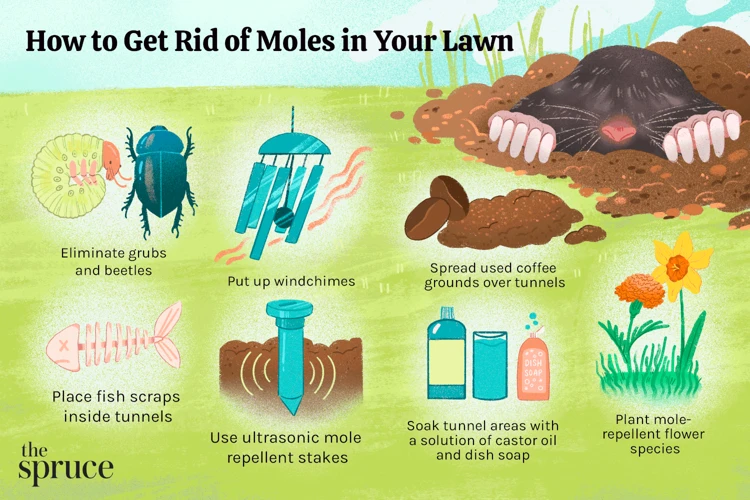
If you’ve been noticing strange mounds of dirt in your lawn or garden, chances are you have a mole problem. Moles can cause significant damage to your property and it’s important to understand these creatures in order to choose the best method for mole control. In this section, we’ll explore the basics of moles and the damage they can cause to your lawn and garden. Understanding these factors will help you make informed decisions on how to best tackle your mole problem. To learn more about repairing mole damage, check out our article on repairing mole damage in your lawn and garden.
Moles 101: What You Need to Know
Moles are small, subterranean creatures that can cause significant damage to your lawn and garden. Here are some essential facts that you should know about moles:
- Appearance: Moles have a cylindrical body that is covered in silky fur, and they typically measure about 6 to 8 inches in length.
- Habits: Moles are active year-round but are most active in the spring and fall. They are solitary creatures and typically do not travel more than 100 yards from their tunnel systems.
- Diet: Moles primarily feed on insects and earthworms found in the soil. While they do not eat plant roots, their digging activities can indirectly damage plants by exposing them to air and moisture, which can cause them to wither and die.
- Tunnel systems: Moles create a network of tunnels in the soil as they search for food. They typically have both shallow and deep tunnels, and their tunnel systems can cover large areas of lawn and garden.
- Reproduction: Moles breed once a year in the early spring, producing litters of three to six offspring. The young stay with their mothers for about a month before venturing out on their own.
While moles may seem like harmless creatures, the damage they can cause to your lawn and garden can be significant. Understanding their behavior and habits is the first step to finding the right mole repellent or prevention method for your needs. To learn more about preventing damage from moles, check out our article on Preventing Mole Damage: Tips and Tricks.
The Damage Moles Can Cause
Moles may seem like harmless, cute creatures that simply burrow underground. However, they can cause significant damage to your lawn and garden if they are left untreated. Here are some of the ways moles can damage your property:
- Digging deep tunnels: Moles can create complex underground tunnels as they search for food, which can eventually lead to surface tunnels and mounds of soil that can be unsightly and make it difficult to mow the lawn.
- Uprooting plants: As moles burrow underground, they may uproot plants and damage their root systems, which can lead to stunted growth or death.
- Killing grass: Moles may eat the insects that live in your lawn, which can make your grass turn yellow and eventually die.
- Attracting other pests: Moles can attract other pests, such as voles, that can cause additional damage to your lawn and garden.
These are just some examples of the damage that moles can cause. It’s important to address the issue as soon as you notice it to prevent further destruction. If you’re not sure if it’s moles causing the damage, check out our article on moles vs. voles damage in your lawn and garden.
Types of Mole Repellents
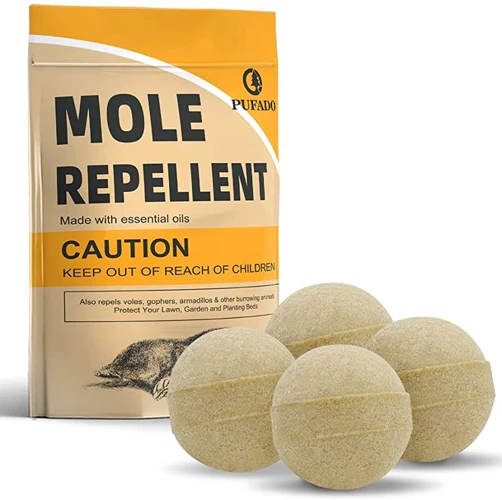
When it comes to getting rid of moles in your lawn and garden, there are various ways to repel them. Some people prefer to use natural remedies like castor oil or chili powder, while others opt for chemical repellents such as poison baits or granules. Each has its pros and cons, so it’s important to choose the right type of mole repellent for your particular situation. Understanding the damage moles can cause (as seen in our previous section) is also crucial in selecting the appropriate tactics for mole control.
Natural Mole Repellents
When it comes to natural mole repellents, there are several options that have been found to be effective. One natural repellent is castor oil, which can be applied to your lawn and garden. When moles encounter this substance, it irritates their skin and causes them to flee. Predator urine is another natural repellent option. The scent of a predator can make moles feel threatened and scared. You can purchase predator urine online or at many garden centers. Eucalyptus oil is also a natural option, as moles dislike the scent. Another natural option is planting daffodils, alliums, and marigolds. These plants naturally repel moles due to their strong scent. Additionally, maintaining a healthy and weed-free lawn can help repel moles, as they tend to inhabit areas with loose soil.
While natural mole repellents may be a more environmentally-friendly option, it is important to note that they may not be as strong as chemical repellents. However, if you are looking for a more natural solution, these options may be worth trying. It is also important to note that prevention techniques, such as keeping your lawn healthy and well-maintained, may be the most effective way to deter moles. To learn more about preventing mole damage, check out our article on repairing mole damage in your lawn and garden, or our article on early action for mole damage. And, for more natural remedies for moles, check out our article on natural solutions for moles.
Chemical Mole Repellents
Chemical Mole Repellents should be used with caution as they contain potentially harmful chemicals. They are often more effective than natural remedies, but may also have a greater environmental impact. Here are some popular types of chemical mole repellents:
| Chemical Mole Repellent | Active Ingredient | Effectiveness | Environmental Impact |
|---|---|---|---|
| Castor Oil-Based Repellents | Castor oil | Effective in some cases | Low environmental impact |
| Mothball-Based Repellents | Naphthalene | Effective in some cases | High environmental impact |
| Aluminum Ammonium Sulfate | Aluminum ammonium sulfate | Effective in some cases | High environmental impact |
| Cyanide Gas-Based Repellents | Sodium cyanide | Highly effective | Very high environmental impact |
Castor oil-based repellents are a popular choice as they are safe for pets and wildlife, and have a low environmental impact. Mothball-based repellents contain naphthalene which is toxic to animals and has a high environmental impact. Aluminum ammonium sulfate based repellents are effective but also have a high environmental impact. Cyanide gas-based repellents are highly effective but are very dangerous and have a very high environmental impact.
Before choosing a chemical mole repellent, it is important to consider the effectiveness and environmental impact of the product. It is recommended to consult with a professional or do research to determine the most suitable product for your specific situation.
Factors to Consider When Choosing a Mole Repellent
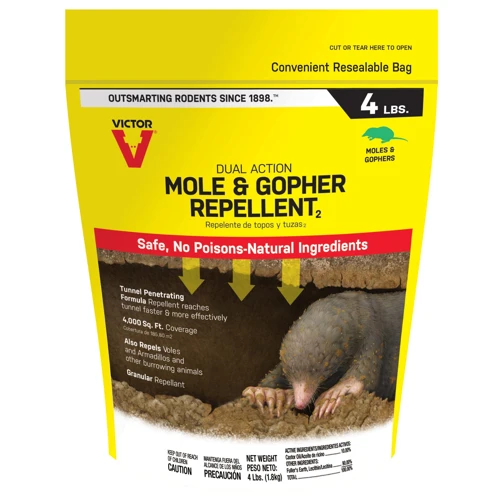
When looking for a mole repellent for your lawn and garden, there are several important factors to consider. Choosing the right mole repellent can be a daunting task, especially with so many options available. It is essential to take into consideration the size of your lawn or garden, the environmental impact of the repellent, its effectiveness, and your budget. By taking these factors into account, you can make an informed decision about the best mole repellent for your specific needs. Let’s take a closer look at each of these factors.
The Size of Your Lawn or Garden
One of the most important factors to consider when choosing a mole repellent is the size of your lawn or garden. The larger the area, the more of the repellent you will need to use. It’s important to choose a repellent that is designed to cover the size of your lawn or garden, as using too little can result in an ineffective treatment.
To help you choose a mole repellent that is suitable for the size of your lawn or garden, we have created this useful comparison table:
| Size of Lawn or Garden | Recommended Repellent |
|---|---|
| Small – up to 1,000 sq ft | Critter Ridder Animal Repellent Granules |
| Medium – up to 5,000 sq ft | Bonide Molemax Mole & Vole Animal Repellent Granules |
| Large – up to 10,000 sq ft | Mole Scram Professional |
| Very Large – over 10,000 sq ft | Tomcat Mole Killer |
It’s important to note that these are just recommendations based on the size of your lawn or garden. You should also take into account other factors such as the level of mole activity in your area and the severity of the infestation. If you have a particularly severe mole problem, you may need to use a larger quantity of repellent or choose a more potent option.
Be sure to carefully read the product label and instructions to determine the appropriate amount of repellent to use for your specific needs. Choosing the right amount of repellent based on your lawn or garden size will help ensure optimal effectiveness and save you from unnecessary spending.
Environmental Impact
When choosing a mole repellent for your lawn and garden, it is important to consider the environmental impact of the product. Here are some factors to keep in mind:
- Biodegradability: Look for mole repellents that are biodegradable and won’t harm the soil or surrounding vegetation. Avoid products that contain hazardous chemicals or toxins that could cause long-term damage to the environment.
- Non-toxic: Choose a mole repellent that is non-toxic and safe for use around children and pets. Chemical-based repellents may be effective, but they may also pose a risk to the health and safety of your family members and the environment.
- Sustainability: If sustainability is a concern for you, consider using natural mole repellents, such as castor oil or chili peppers, which may be more environmentally-friendly than chemical-based alternatives.
- Packaging: Consider the packaging of the mole repellent. Choose products that come in recyclable or reusable containers, and avoid those that use excessive packaging or single-use plastics.
- Manufacturing practices: Research the manufacturer of the mole repellent to determine their environmental policies and practices. Look for companies that use sustainable materials, eco-friendly manufacturing processes, and support environmental initiatives.
By taking these environmental factors into consideration when choosing a mole repellent, you can help protect your lawn and garden while also doing your part to preserve the environment.
Effectiveness
One of the most important factors to consider when choosing a mole repellent is its effectiveness. After all, you don’t want to spend time and money on a product that won’t actually keep moles away. Here are some things to keep in mind when evaluating a mole repellent’s effectiveness:
- Type of repellent: Natural repellents may not be as potent as chemical ones, but they are generally safer for the environment and your pets. Chemical repellents may be more effective, but they also pose more risks.
- Duration: How long does the repellent last? Some products need to be reapplied more frequently than others in order to maintain their effectiveness.
- Reviews: Before purchasing a mole repellent, check out reviews from other customers to see how well it has worked for them. Keep in mind that results may vary depending on a variety of factors, but if a product consistently receives poor reviews, it’s probably not worth trying.
- Active ingredients: Look for products that contain active ingredients known to be effective against moles, such as castor oil, essential oils, or capsaicin. Be sure to research the effectiveness and safety of these ingredients before using them.
Ultimately, the most effective mole repellent will depend on your individual needs and preferences, as well as the specific mole problem you’re dealing with. Don’t be afraid to experiment with different products until you find one that works well for you.
Budget
When it comes to choosing a mole repellent, budget is a crucial factor to consider. Here are a few things to keep in mind:
- Price: Mole repellents come in a range of prices, from a few dollars for natural remedies to upwards of $100 for chemical treatments. Determine what you’re comfortable spending before you start shopping.
- Long-term Cost: While some natural remedies may be cheaper upfront, they may require more frequent applications than a chemical repellent, which can be more expensive in the long run. Consider the overall cost of the product, taking into account how often you’ll need to apply it and how much you’ll need each time.
- Value for Money: Look for products that offer a good balance between price and effectiveness. A more expensive product may be more effective, but it may not be the best value for your budget.
Don’t let budget be the only factor in your decision-making process, as choosing a cheaper product that isn’t effective could end up costing you more in the long run. However, by taking the time to research and compare different options, you can find a mole repellent that fits your budget and is still effective.
The Best Mole Repellents on the Market
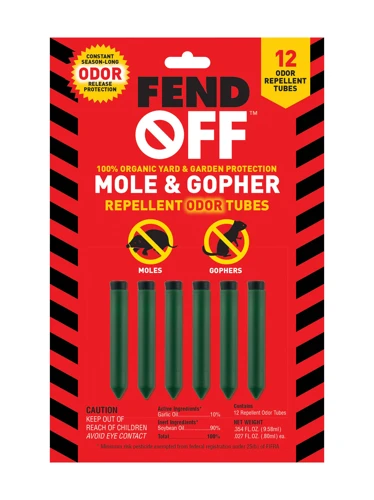
After understanding the potential damage that moles can inflict on your lawn and garden, you’ll want to take action to protect your outdoor space. However, with the abundance of mole repellents on the market, it can be overwhelming to choose the best option for your needs. To make things easier, we’ve researched and compiled a list of highly effective mole repellents that are available for purchase. In this section, we’ll highlight several top-rated mole repellents and provide an overview of each one to help you make an informed decision.
Critter Ridder Animal Repellent Granules
One of the best mole repellents on the market is Critter Ridder Animal Repellent Granules. This natural repellent uses a combination of pepper, oil of black pepper, and piperine to create an intense odor that repels not only moles, but also other animals such as raccoons, skunks, and squirrels.
Here are some key features and benefits of Critter Ridder Animal Repellent Granules:
- Natural ingredients: The use of natural ingredients makes this mole repellent safe for pets and children.
- Multi-animal repellent: The combination of ingredients is effective not only against moles but also against other animals that can cause damage to your lawn and garden.
- Long-lasting: One application of this repellent can last up to 30 days.
- Easy to apply: Simply sprinkle the granules around the perimeter of your lawn, garden, or other areas you want to protect.
Critter Ridder Animal Repellent Granules is a great option for those who prefer natural repellents and want to avoid the use of chemicals. However, it’s important to note that while this repellent is effective, it may take some time to see results. Persistence and consistent application is key when using any mole repellent.
Bonide Molemax Mole & Vole Animal Repellent Granules
One of the top-rated mole repellents on the market is the Bonide Molemax Mole & Vole Animal Repellent Granules. This chemical repellent contains castor oil as its active ingredient, which drives the moles and voles away from your lawn and garden. The active ingredient is environmentally safe and poses no risk to pets or children.
What sets this product apart from other chemical mole repellents is its long-lasting formula. The granules provide protection for up to three months and can cover up to 5,000 square feet of your lawn or garden. It is also rain-resistant, ensuring that the repellent stays effective even during rainy weather.
To use the Bonide Molemax repellent, spread the granules evenly over the affected area and water them down to activate. The granules are odorless and won’t leave behind any residue that could harm your pets or plants. One 10-pound bag of Bonide Molemax can treat an area up to 10,000 square feet, making it a cost-effective solution for larger lawns and gardens.
It is important to note that this repellent is not designed to kill moles or voles. Instead, it works to deter them from your lawn and garden by making the environment undesirable for their habitat. For best results, reapply the granules every three months or as needed.
Table comparing Bonide Molemax Mole & Vole Animal Repellent Granules with other mole repellents:
| Product Name | Active Ingredient | Coverage Area | Duration of Protection | Kills Moles? |
|---|---|---|---|---|
| Bonide Molemax Mole & Vole Animal Repellent Granules | Castor oil | Up to 5,000 sq ft (10lb) or 10,000 sq ft (20lb) | Up to 3 months | No |
| Critter Ridder Animal Repellent Granules | Peppermint Oil, Cinnamon Oil, Citronella Oil | Up to 1,350 sq ft (1.25lb) | Up to 30 days | No |
| Talpirid Mole Bait | Bromethalin | 1 bait block covers 1/4 acre | N/A | Yes |
| Vibrarodent Sonic Mole Repellent | Ultrasonic vibrations | Up to 11,000 sq ft (1 unit) | N/A | No |
Tomcat Mole Killer
Tomcat Mole Killer is a highly effective mole repellent that comes in the form of ready-to-use bait. It contains the active ingredient Bromethalin, which is a potent neurotoxin that is lethal to moles upon ingestion. The bait is designed to mimic the earthworms, a common prey of moles. This makes it highly attractive to them, and they are likely to consume it easily.
Pros:
- Highly effective in killing moles within 24-48 hours upon ingestion
- Easy to use and apply
- Designed to mimic the earthworms, making it highly attractive to moles
- Controls both mole and vole populations
Cons:
- Not environmentally friendly, as it contains a potent neurotoxin
- May harm non-target wildlife, such as birds of prey, and pets
- May require multiple applications to completely eliminate the mole population in larger areas
- Not cost-effective for larger areas
It is important to handle the bait with care and follow the instructions on the package when using this mole repellent. Tomcat Mole Killer is not recommended for use near vegetable gardens or edible crops. It is also important to keep pets and children away from the treated area until the bait has been completely removed.
Tomcat Mole Killer is a highly effective mole repellent that can quickly and efficiently eliminate mole populations. However, it should be used with caution and only as a last resort after other natural repellent methods have been tried and failed.
Mole Scram Professional
Mole Scram Professional is a top-rated mole repellent that is designed to protect your lawn and garden from the damage caused by moles. This repellent uses natural ingredients, making it safe for use around pets and children. Here are some key features and benefits of Mole Scram Professional:
- Effective: Mole Scram Professional is highly effective at repelling moles from your lawn and garden. The active ingredients are designed to both repel and irritate moles, making them less likely to stick around.
- Easy to use: Applying Mole Scram Professional is easy and straightforward. Simply sprinkle the granules across the affected area and water them in with a hose or sprinkler.
- Long-lasting: Mole Scram Professional is designed to provide long-lasting protection against moles. The granules will continue to repel moles for up to three months after application.
- Natural ingredients: Mole Scram Professional uses natural ingredients that are safe for use around pets and children. The active ingredients include castor oil, garlic, and citronella oil.
- Environmentally friendly: Unlike some chemical mole repellents, Mole Scram Professional is environmentally friendly and won’t harm the soil or other animals in your yard.
- Concentrated formula: Mole Scram Professional comes in a concentrated formula, so a little goes a long way. Each bag can cover up to 3,500 square feet.
Mole Scram Professional is an excellent choice for those who want an effective and safe mole repellent for their lawn and garden. Its natural ingredients, ease of use, and long-lasting protection make it a top choice among homeowners.
How to Apply Mole Repellent
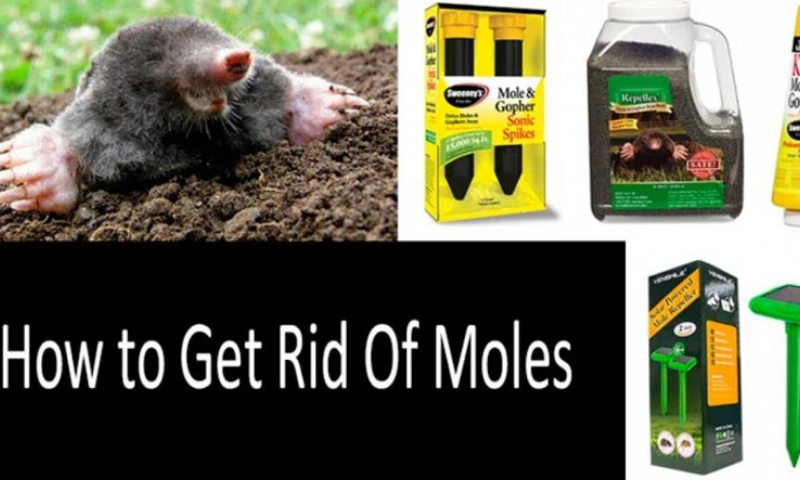
Now that you’ve chosen the best mole repellent for your lawn and garden, it’s time to learn how to apply it. Proper application is crucial to ensure the repellent works effectively and keeps moles at bay. This step-by-step guide will walk you through the process of applying mole repellent and provide tips for optimal results. Whether you’re using granules or a mole killer, following these instructions will help you get the most out of your chosen repellent.
Step-by-Step Guide
To apply mole repellent to your lawn or garden, follow these simple step-by-step guide:
- Determine the area where you have noticed mole activity. This could be determined by identifying raised ridges or soft, sunken areas on your lawn.
- Choose the type of mole repellent that best suits your needs. Consider the size of your lawn or garden, the environmental impact, and the effectiveness of the chosen repellent.
- Read the instructions on the chosen repellent carefully. Pay attention to recommended application rates, safety precautions, and the frequency of application.
- Prepare the area by removing any debris, such as leaves or grass clippings, that may obstruct the repellent’s effectiveness. Level the soil if necessary.
- Apply the mole repellent as directed. This may involve spreading granules or spraying liquid repellent directly onto the soil. Be sure to cover the entire identified area with the repellent.
- Water the area where you have applied the repellent. This helps the repellent sink into the soil and become more effective.
- Monitor the area for signs of mole activity. Repeat the application as needed according to the instructions provided with the chosen repellent.
Remember, it may take some time for the mole repellent to take effect. Be patient and consistent with the application to see the best results. Following these simple steps can help you effectively apply mole repellent to your lawn or garden and limit any potential damage caused by moles.
Tips for Optimal Results
For optimal results when applying mole repellent, consider the following tips:
- Read and follow the instructions carefully: Different types of repellents require different application methods and quantities. Make sure to carefully read the instructions and apply the product correctly.
- Apply on a dry day: Wet soil can make it difficult for repellents to penetrate and be effective, so it’s best to apply mole repellent on a dry day.
- Apply the repellent before watering: If you’re planning on watering your lawn or garden, make sure to apply the repellent before doing so. Water can dilute and wash away the product, reducing its effectiveness.
- Apply around the perimeter of your lawn or garden: Moles typically enter lawns and gardens from the edges, so focus on applying the repellent around the perimeter.
- Reapply as needed: Most mole repellents need to be reapplied every 2-3 months for maximum effectiveness. Follow the product’s instructions for reapplication.
- Keep an eye out for new mole activity: If you notice new mole tunnels or activity, it may be time to reapply the repellent or try a different product. Early detection is key to keeping moles away from your lawn or garden.
By following these tips, you can increase the effectiveness of your chosen mole repellent and keep your lawn and garden free from mole damage.
Prevention Tips to Keep Moles Away
To prevent moles from invading your lawn or garden, there are several steps you can take. One effective strategy is to create physical barriers that make it difficult for moles to tunnel through the soil. This can be achieved by using hardware cloth or chicken wire to line the bottom of your garden beds or planting areas.
Another way to deter moles is to remove their food sources. Moles primarily feed on earthworms, so if you can reduce the earthworm population in your lawn or garden, you can make the area less attractive to moles. Encouraging songbirds to visit your yard can also help to reduce the earthworm population.
Reduce the amount of water that your lawn or garden receives, as well. Moles are attracted to moist soil, so if you can keep the soil dry, they will be less likely to tunnel through it.
Finally, you can plant natural repellents in your garden to keep moles away. Plants that have strong odors, such as alliums, daffodils, and marigolds, can be effective deterrents. Similarly, plants that have prickly leaves, such as euphorbias, can make it difficult for moles to tunnel through the soil.
By taking these preventative measures, you can reduce the likelihood that moles will invade your lawn or garden. Remember that prevention is often the most effective way to deal with pests, so don’t wait until you have a mole problem to start taking action.
Conclusion
In conclusion, choosing the best mole repellent for your lawn and garden requires careful consideration of various factors. There are both natural and chemical repellents available, each with their own advantages and disadvantages.
When choosing a repellent, it is important to consider the size of your lawn or garden, as well as the potential environmental impact of the product. In addition, you will want to select a product that is effective at keeping moles at bay, without breaking the bank.
Some of the best mole repellents on the market include Critter Ridder Animal Repellent Granules, Bonide Molemax Mole & Vole Animal Repellent Granules, Tomcat Mole Killer, and Mole Scram Professional. Each of these products has been proven to provide excellent results in discouraging moles from damaging your lawn and garden.
When applying mole repellent, be sure to follow the manufacturer’s instructions carefully. It is also important to take steps to prevent moles from returning to your lawn and garden in the future. This may include things like removing their food sources and improving the overall health of your soil.
By taking the time to select a high-quality mole repellent and following some simple prevention tips, you can keep moles at bay and enjoy a beautiful, healthy lawn and garden for years to come.
Frequently Asked Questions
How do moles damage lawns and gardens?
Moles create tunnels underground, which can damage plant roots and cause plants to die. Their tunnels can also make lawns bumpy and uneven.
Can I use both natural and chemical mole repellents?
It is not recommended to use both types of mole repellents at the same time, as they can cancel out each other’s effectiveness. Choose one type and follow the instructions carefully.
Do mole repellents harm other animals?
Most mole repellents are designed to only repel moles, but it’s important to check the label and make sure they won’t harm other animals in your lawn or garden.
How often should I apply mole repellent?
It depends on the type of mole repellent and the manufacturer’s instructions. Some may need to be reapplied every few weeks, while others may last for several months. Make sure to read the label carefully.
Can I use mole repellent around edible plants?
It’s important to check the label before applying mole repellent near edible plants. Some products may not be safe for use around food crops.
Will moles eventually leave on their own?
Moles will continue to burrow in your lawn and garden as long as there is food available. It’s unlikely that they will leave on their own, so mole repellent may be necessary.
Do ultrasonic mole repellents work?
While some people find ultrasonic mole repellents to be effective, research is mixed on their overall effectiveness. It’s important to use them in conjunction with other mole repellent methods for best results.
Do wind chimes or other noise-making devices repel moles?
There is no scientific evidence to support the idea that noise-making devices repel moles. It’s better to use proven mole repellent methods instead.
Do mole repellents work in all types of soil?
Some mole repellents may be more effective in certain types of soil than others. It’s important to choose a mole repellent that is specifically designed for your type of soil.
Can I prevent moles from entering my lawn or garden in the first place?
Yes, by removing their food sources. Moles feed on grubs and insects, so keeping your lawn and garden healthy and free of insects can help prevent moles from coming around.







